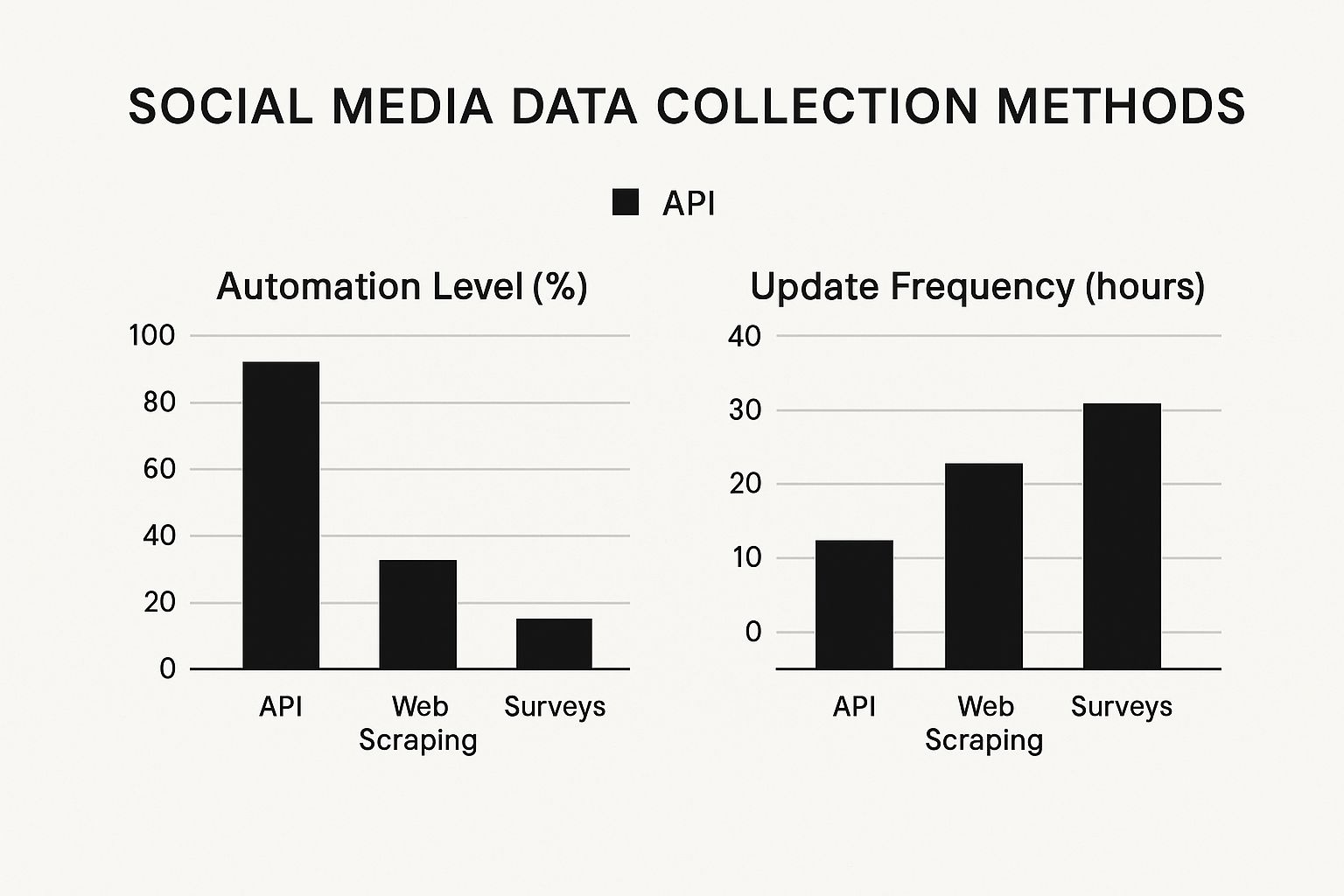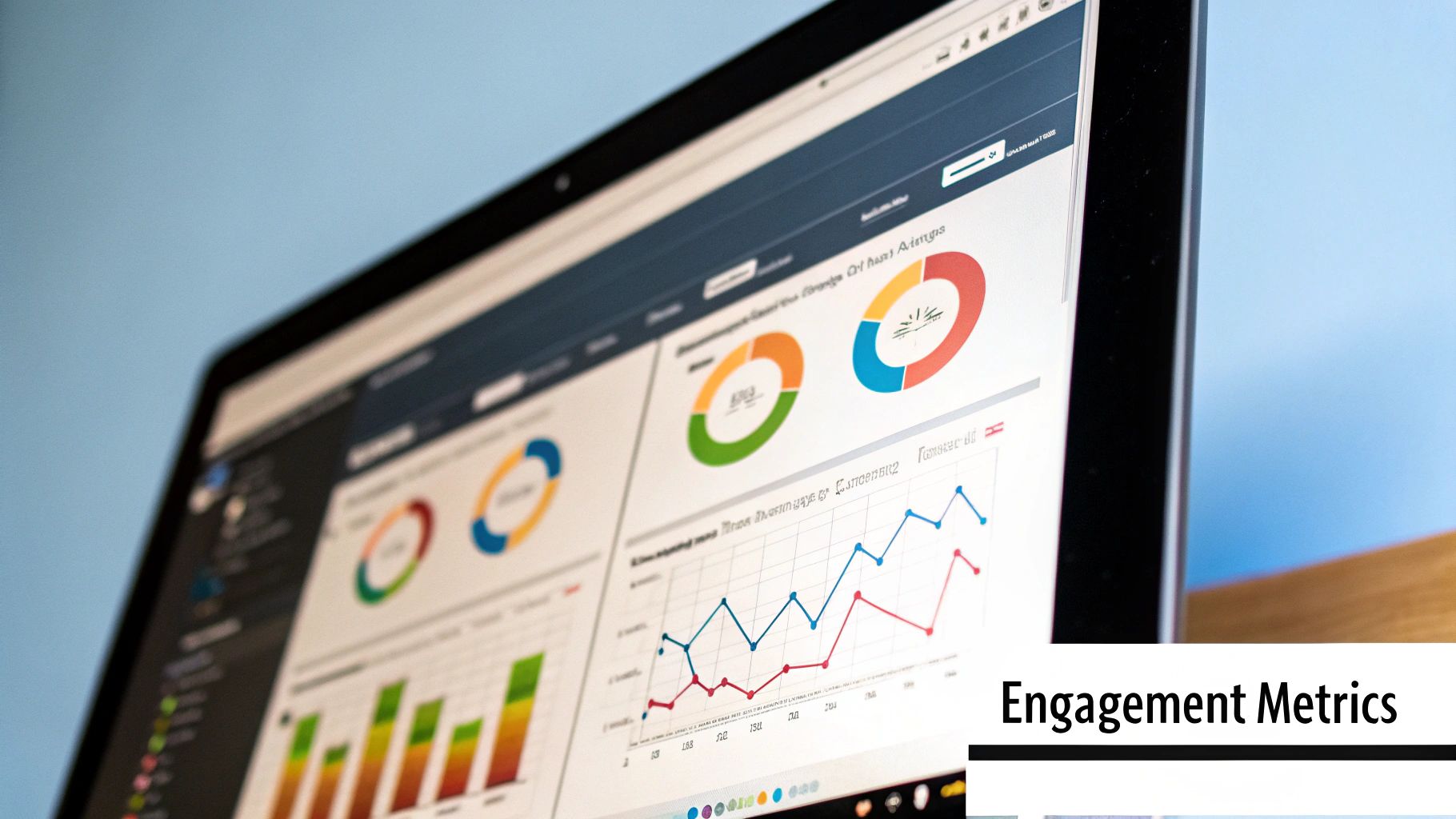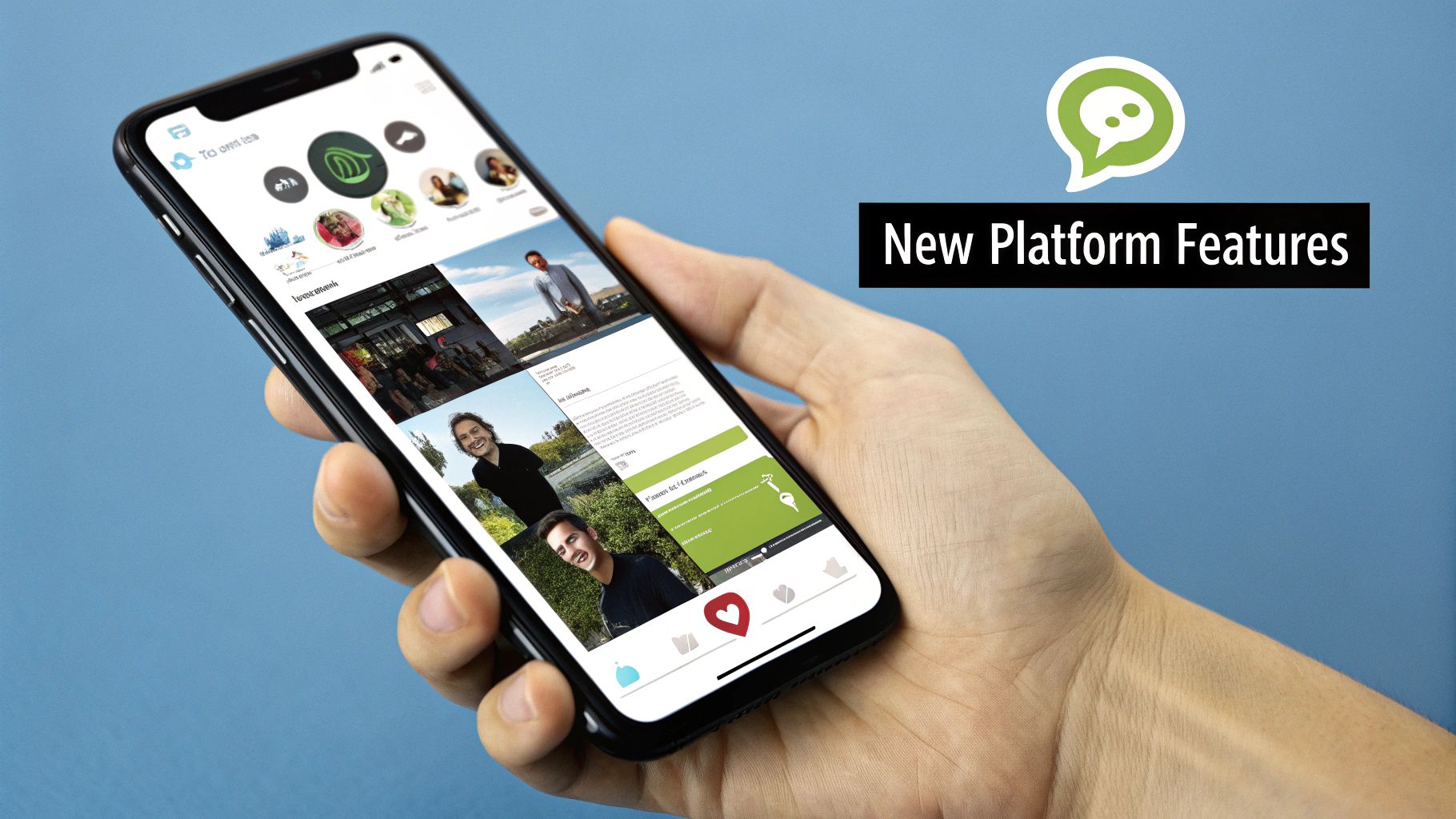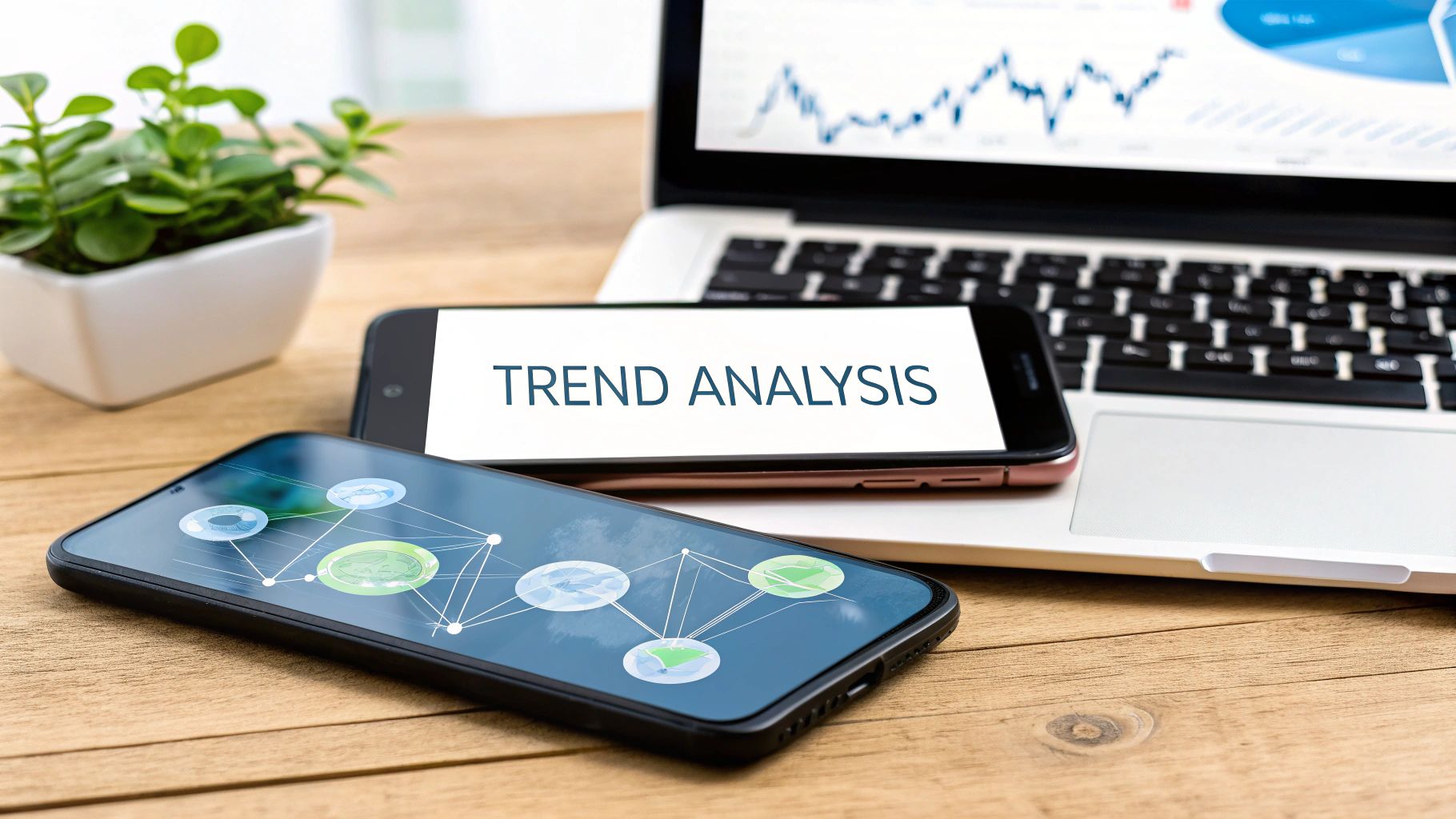Navigating Today's Global Social Media Landscape

Understanding the constantly evolving digital world is critical for success. Social media trend analysis offers a roadmap for navigating this complex environment, explaining why some trends flourish while others disappear. This analysis provides valuable insights into the changing behaviors and preferences of online audiences.
Armed with this knowledge, businesses can adapt their strategies, connect with their target demographics, and achieve significant results.
Understanding the Scope of Social Media
The sheer scale of social media’s impact is a major factor in trend analysis. As of early 2025, approximately 5.31 billion people globally use social media, representing about 64.7% of the world's population. This widespread use highlights the increasing reliance on digital platforms for communication and information sharing. Find more detailed statistics here.
This global interconnectedness creates a dynamic space where trends can emerge quickly and spread worldwide. To better grasp the trends landscape, reviewing guides on social media trend analysis offers a helpful starting point.
Identifying Key Trends and Their Impact
For businesses, understanding these trends is not just about staying current; it's about recognizing opportunities. Social media trend analysis helps businesses anticipate shifts in consumer behavior.
For instance, the growth of short-form video content has reshaped how brands interact with their audiences. Recognizing this trend allows businesses to develop engaging video content, capturing the attention of their target demographic and boosting interaction. Understanding which platforms are most effective for specific industries also enables targeted marketing strategies.
To further illustrate the scope of social media usage, let's examine some key statistics:
Global Social Media Usage Statistics Key metrics showing social media penetration and growth across global markets
| Metric | Global Value | Year-over-Year Change | Impact on Trend Analysis |
|---|---|---|---|
| Total Number of Social Media Users | 5.31 Billion | (Data not provided in original text) | Reflects the growing global reach of social media and its influence on trends. |
| Percentage of World's Population Using Social Media | 64.7% | (Data not provided in original text) | Demonstrates the pervasive nature of social media and its importance for businesses. |
These statistics underscore the importance of considering social media trends when developing marketing strategies. The continuous growth in user numbers emphasizes the expanding potential reach and influence of social media platforms.
Practical Applications of Trend Analysis
Social media trend analysis isn’t simply theoretical; it offers powerful tools with real-world uses. This analysis can guide businesses in making informed decisions about their marketing strategies, product development, and even customer service.
By understanding emerging trends, brands can better anticipate their target audience's needs and wants, ensuring their products and services resonate. Staying ahead of the curve allows companies to capitalize on new opportunities and minimize potential risks. The insights from social media trend analysis empower organizations to be proactive and innovative, fostering growth.
Platform Insights: Where Valuable Trends Actually Emerge
Not all social media platforms offer the same depth of insight. Knowing where to concentrate your social media trend analysis is key to efficient data gathering and generating relevant insights tailored to your specific needs. This involves understanding the distinct strengths of each platform and their respective audiences and content formats.
Understanding Platform-Specific Trends
Each platform cultivates its own unique user base and culture, resulting in distinct trends. Facebook, with its expansive demographic reach, is a valuable resource for identifying large-scale societal shifts and evolving consumer preferences. Instagram, a visually driven platform, excels at showcasing emerging trends in fashion, beauty, and lifestyle. A fashion brand, for example, might analyze Instagram to gauge the popularity of certain clothing styles or accessories. For those interested in Twitter trends, here's a helpful resource: 5 Best Practices for Engaging With Trending Tweets.
TikTok, known for its short-form video content, is the go-to platform for discovering viral challenges, trending music, and emerging comedic styles. LinkedIn, on the other hand, provides key insights into professional trends, industry discussions, and the ever-evolving world of B2B marketing. This platform specialization empowers businesses to fine-tune their trend analysis, ensuring relevance and actionable insights.
Multi-Platform Analysis for a Complete Picture
While focusing on individual platforms offers granular data, a multi-platform approach to social media trend analysis paints a more comprehensive picture. Analyzing trends across multiple platforms allows you to identify overarching patterns and verify the true reach of a trend. This broader perspective also helps differentiate between platform-specific fads and significant cultural shifts. For instance, a trend appearing on TikTok, Instagram, and Twitter likely signals a larger cultural movement compared to a trend isolated to a single platform.
One of the most compelling aspects of social media trends is the sheer user volume concentrated on major platforms. In 2025, platforms like Facebook, YouTube, Instagram, and WhatsApp each boast over two billion active users. The average person engages with approximately 6.7 different social platforms. This user density underscores the significance of these platforms in shaping global online interactions. You can find more detailed statistics here: Global Social Networks Ranked by Number of Users.
Data Collection Methods Comparison
Understanding the various methods for collecting social media data is essential for effective trend analysis. The following infographic compares three common methods: API, Web Scraping, and Surveys, highlighting their automation level and update frequency.

APIs offer the highest degree of automation and the most frequent updates, making them ideal for real-time trend tracking. Surveys, while valuable for gathering in-depth qualitative data, have lower automation and less frequent updates. Web scraping offers a middle ground, balancing automation and update frequency. Selecting the optimal method hinges on the specific requirements of your social media trend analysis.
To further illustrate the strengths and weaknesses of each platform, consider the following comparison:
Comparative Platform Analysis Framework: A comparison of major social platforms' analytical capabilities and data points
| Platform | Key Metrics Available | Trend Signal Strength | Best For | Limitations |
|---|---|---|---|---|
| Reach, engagement, demographics, sentiment | Strong for broad trends | Identifying large-scale shifts, consumer preferences | Can be noisy, requires filtering | |
| Engagement, hashtags, visual trends | Strong for visual and lifestyle trends | Fashion, beauty, product discovery | Less effective for text-based trends | |
| TikTok | Viral challenges, music trends, emerging humor | Strong for youth culture and short-form video | Identifying early-stage trends, influencer marketing | Limited demographic reach |
| Professional trends, industry discussions, B2B insights | Strong for professional networking and B2B | Industry analysis, recruitment | Less effective for B2C trends |
This table highlights the diverse strengths of each platform, enabling a more strategic approach to trend analysis. By understanding these differences, businesses can select the most appropriate platforms for their specific needs and gain more valuable insights.
Tools and Techniques That Actually Reveal Insights

Going beyond basic social media trend analysis means understanding the tools and techniques the pros use. These tools provide real, actionable data, keeping brands ahead of the game. It all comes down to having the right resources for effective analysis.
Essential Tools for Trend Spotting
Several key tools play a vital role in effective social media trend analysis. Social listening tools monitor brand mentions and conversations across different social media platforms. They provide valuable information about public sentiment and emerging topics. Google Trends analyzes search data, giving you a clear picture of rising keyword popularity and where that interest is coming from geographically. Specialized platforms like Reply Guy help users find trending tweets on X (formerly Twitter). This allows brands to join viral conversations at the right time, expanding reach and growing their following.
Social media analytics tools, like those built into Facebook, Instagram, and TikTok, offer detailed data on engagement, reach, and audience demographics. These metrics provide useful insights into what connects with your audience and can highlight emerging content formats. These resources help businesses understand where consumer attention is actually going.
Advanced Techniques for Deeper Analysis
Collecting data is only the first step. Professionals use a combination of advanced techniques to stay competitive. Sentiment analysis categorizes online conversations as positive, negative, or neutral, providing valuable context to emerging trends. Conversation monitoring tracks discussions around specific keywords and hashtags, revealing subtle details about audience perceptions.
Predictive modeling uses historical data to anticipate future trends, letting brands create content proactively and strategically. Combining these techniques transforms raw data into valuable foresight, enabling businesses to capitalize on trends before they hit their peak. The ongoing growth of social media underscores its importance. By 2025, over 99% of social media users will access platforms via smartphones. This shift towards mobile access reflects wider technological changes and shows how adaptable social platforms are. You can find more detailed statistics here: Top Social Media Platforms by User Statistics.
Building an Integrated System
Leading organizations don't just rely on individual tools. They build complete systems that combine data from multiple sources to see the whole social media picture. This lets businesses connect the dots between different data points, uncovering deeper insights into how trends develop.
For example, combining social listening data with Google Trends validates a trend's true reach and identifies patterns before competitors. This cross-platform approach creates a powerful feedback loop. These systems not only identify emerging trends but follow them throughout their lifecycle, from the very beginning to widespread adoption. Analyzing the entire lifespan of a trend leads to more accurate predictions and more effective marketing strategies.
Choosing the Right Approach
The best mix of tools and techniques depends on your specific goals. A small business might prioritize easily accessible tools like Google Trends and the analytics built into social media platforms. Larger organizations might invest in broader social listening and predictive modeling solutions. By carefully evaluating resources and matching them with business objectives, brands can maximize their social media trend analysis. This knowledge helps organizations predict changes in consumer behavior, find new opportunities, and make informed decisions.
Transforming Social Data into Strategic Insights
The sheer volume of social media data available can feel overwhelming. The true difficulty isn't collecting the data, but extracting meaningful insights to inform strategic decisions. This is where effective social media trend analysis plays a vital role. It acts as a bridge, connecting raw data with actionable intelligence, empowering businesses to understand and utilize the constantly evolving dynamics of online conversations.
Categorizing Trend Types
A critical aspect of social media trend analysis is categorizing different types of trends. This structured approach helps businesses understand the potential impact of each trend. Key categories include:
Emerging Trends: These are newly developing patterns gaining traction, often starting within niche online communities or specific platforms. Recognizing these early can give businesses a significant competitive advantage.
Cyclical Trends: These trends re-emerge periodically, often linked to seasonal factors or recurring events. Understanding their cyclical nature allows for proactive planning and optimized resource allocation.
Disruptive Trends: These represent significant shifts that fundamentally change the social media landscape. They often involve new technologies, platforms, or content formats, requiring businesses to adapt quickly to remain relevant.
Declining Trends: Recognizing declining trends is just as crucial as spotting emerging ones. Understanding which trends are losing momentum helps businesses avoid wasting resources on ineffective strategies.
Contextualizing Social Data
Effective social media trend analysis goes beyond simply identifying trends; it requires placing them in the context of wider market conditions. This involves understanding how social media data connects to overall consumer behavior, industry developments, and macroeconomic trends. For example, a sudden increase in discussions about a particular product on social media could be linked to a new product release, a competitor's marketing campaign, or even a shift in overall economic sentiment.
Distinguishing between short-lived viral moments and substantial, long-term shifts is crucial. Not every viral trend has staying power. By analyzing the duration and depth of engagement surrounding a trend, businesses can determine its true significance. To truly convert social data into strategic insights, leveraging the right tools is essential. Consider using top-rated social media analytics tools.
Building Effective Systems
Developing systems that consistently filter meaningful signals from the noise of social media is essential for successful trend analysis. This involves:
Defining clear objectives: Identifying the specific insights you're looking for is the first step.
Selecting appropriate monitoring tools: Choosing the right platforms and tools that align with your goals will ensure you're gathering relevant data.
Establishing data filtering mechanisms: Implementing effective filters will help you pinpoint relevant data points amidst the constant influx of information.
Developing reporting and analysis frameworks: Establishing clear frameworks will help you interpret and communicate your findings effectively.
By implementing these strategies, businesses can turn social data into a powerful resource for strategic decision-making, enabling them to anticipate market changes, adapt to new trends, and refine their social media strategies. You might also want to explore how to master Twitter Analytics. This can significantly enhance your ability to identify and interpret key trends on the platform.
Predictive Analysis: Spotting Trends Before They Emerge

True competitive advantage on social media isn't simply about reacting to what's trending now; it's about anticipating what's next. This proactive approach is powered by predictive analysis, a technique that allows organizations to identify and capitalize on emerging trends before they hit the mainstream. This foresight gives businesses a significant head start.
Pattern Recognition and Early Signals
Predictive analysis hinges on recognizing patterns in social media data. Much like meteorologists use weather patterns to forecast conditions, social media analysts look for recurring themes and conversations. These patterns, coupled with an understanding of cultural shifts, provide valuable clues about future trends.
Identifying these early signals amid the constant flow of social media requires specialized techniques. For instance, monitoring the growth of niche hashtags or the early adoption of new content formats can be indicative of an emerging trend. You might be interested in this article on how to find trending topics on Twitter. These seemingly small changes can often foreshadow broader cultural movements.
Building Predictive Systems
Successful organizations use sophisticated systems to monitor trends throughout their entire lifecycle. These systems go beyond simple data gathering and employ advanced analytical techniques. They offer a comprehensive view of how trends evolve and offer insights into their potential impact.
A key function of these systems is distinguishing between short-lived fads and sustained trends. By analyzing the rate of growth, engagement levels, and the diversity of participants, these systems can estimate a trend's likely longevity. This allows businesses to allocate resources to trends with true staying power.
Combining Quantitative and Qualitative Analysis
Effective predictive analysis necessitates a balanced approach that integrates both quantitative and qualitative data. Quantitative metrics like engagement rates and follower growth offer a measure of a trend's current popularity. However, qualitative cultural analysis provides crucial context, helping to understand the underlying forces driving the trend.
For example, a spike in mentions of a particular product might seem significant quantitatively. But qualitative analysis might reveal that the mentions are largely driven by negative reviews. This nuanced understanding, gained by combining both data types, leads to more informed predictions.
Trend Lifecycle Tracking
Tracking a trend's progression from its origin to widespread adoption yields invaluable information. This process includes:
Identifying the source: Pinpointing where the trend began and which platforms or communities were the early adopters.
Monitoring growth: Tracking how quickly the trend is spreading and which demographics are engaging with it.
Analyzing engagement: Examining the type of content being shared and whether the sentiment is positive, negative, or mixed.
Predicting longevity: Assessing how long the trend is likely to persist and whether it will go mainstream or remain niche.
By understanding these stages, businesses can anticipate a trend's trajectory and make informed decisions about how to engage with it. This proactive approach, driven by predictive analysis, is a key differentiator for success in the constantly evolving social media landscape.
Turning Trend Analysis Into Measurable Results
Social media trend analysis is more than just spotting what's hot; it's about turning those insights into real business results. Even the most insightful analysis is worthless without a concrete plan for implementation. This means transforming observed trends into actionable strategies for marketing, product development, and content creation.
Building a Trend Response Team
Successfully using social media trends requires a coordinated team effort. This begins with assembling a cross-functional response team. This team should include members from different departments, like marketing, product development, customer service, and sales. For example, if a trend develops around a specific product feature, having representatives from both product development and marketing ensures a coordinated and effective response. This collaboration guarantees everyone works toward the same objective, using their expertise to maximize the trend's impact.
Setting Implementation Timelines
Time is critical when responding to social media trends. Trends are fluid and often short-lived. Therefore, establishing appropriate implementation timelines is essential. This involves setting realistic deadlines for developing and launching trend-related initiatives. A fast-moving viral trend might demand a response within hours, while a slower trend might allow for a more deliberate approach over days or weeks. The key is balancing speed and thoroughness, ensuring a timely response without compromising quality.
Measuring ROI of Trend-Driven Initiatives
Showing the return on investment (ROI) of trend-driven initiatives is crucial for justifying continued investment in social media trend analysis. This means establishing clear metrics to measure the success of trend-driven campaigns. These metrics could include website traffic, lead generation, sales conversions, brand mentions, and engagement rates. Tracking these metrics allows businesses to quantify the impact of their efforts and demonstrate the value of social media trend analysis.
Case Studies: Successes and Failures
Learning from both successes and failures is vital for continuous improvement. Examining case studies of organizations that have effectively used social media trend analysis offers valuable lessons. For example, a company that successfully capitalized on a viral trend by launching a well-timed marketing campaign can offer valuable insights into effective strategies. Conversely, analyzing instances where companies missed opportunities or responded poorly to trends can help prevent similar mistakes. These real-world examples offer practical guidance and highlight the importance of adaptability and strategic thinking.
Capitalizing on Early Trend Identification
Identifying trends early provides a significant competitive edge. By recognizing emerging patterns before competitors, businesses can position themselves to capitalize on new opportunities. This could involve developing new products or services aligned with emerging consumer interests, adjusting marketing campaigns to resonate with trending topics, or creating content that taps into the latest viral sensations. However, early identification is not enough. Swift and strategic implementation truly translates trend analysis into a market advantage.
Ready to stop scrolling and start strategizing? Reply Guy helps you identify trending tweets, so you can engage with your audience at the right time and organically grow your following. Check out Reply Guy today and start maximizing your impact on X (formerly Twitter).
